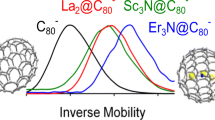Abstract
High sensitivity and spectral resolution provided by pulsed electron paramagnetic resonance and electron nuclear double resonance techniques at high Larmor frequencies open the way for a study of atoms in chemical traps. As an example we studied deuteron atoms encased in silsesquioxane cages to probe the cage symmetry as function of temperature. An analysis of the temperature dependence showed that the system undergoes a structural phase transition near 100 K. At this temperature the character of distortion of the ideal cubic symmetry changes from oblate to prolate (or vice versa). With quantum chemical methods, a model for cage escape of the encased atom could be derived. The calculated escape barrier of 0.9 eV is close to the experimental value derived by thermal release experiments. Although the encased deuterium atom exhibits an isotropic hyperfine coupling constant nearly identical with the free atom value, a spin population analysis revealed that approximately 10% of the spin density is transferred to the cage. We therefore conclude that confinement of the hydrogen atom leads to a compression of its wave function compensating the decrease of spin density. In this respect the system falls somewhat short of the properties of an ideal cage, being defined by well decoupled atomic and molecular wave functions.
Similar content being viewed by others
References
Sasamori R., Okaue Y., Isobe T., Matsuda Y.: Science265, 1691 (1994)
Päch M., Stösser R.: J. Phys. Chem. A101, 8360 (1997)
Weiden N., Goedde B., Käß H., Dinse K.-P., Rohrer M.: Phys. Rev. Lett.85, 1544 (2000)
Anderson L.W., Pipkin F.M., Baird J.C. Jr.: Phys. Rev. Lett.4, 69 (1960)
Törnroos K.W.: Acta Crystallogr. C50 1646 (1994)
Dilger H., Roduner E., Scheuermann R., Major J., Schefzik M., Stößer R., Päch M., Fleming D.G.: Physica288-290, 482 (2000)
Päch M.: Ph.D. Thesis, Technical University Berlin, Berlin, Germany 1997.
Bieniok A.M., Bürgi H.-B.: J. Phys. Chem.98, 10735 (1994)
Almeida Murphy T., Pawlik T., Weidinger A., Höhne M., Alcala R., Spaeth J.-M.: Phys. Rev. Lett.77, 1075 (1996)
Author information
Authors and Affiliations
Rights and permissions
About this article
Cite this article
Weiden, N., Päch, M. & Dinse, K.P. Pulsed EPR and ENDOR investigation of hydrogen atoms in silsesquioxane cages. Appl. Magn. Reson. 21, 507–516 (2001). https://doi.org/10.1007/BF03162424
Received:
Issue Date:
DOI: https://doi.org/10.1007/BF03162424




